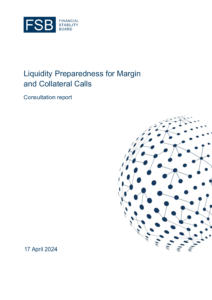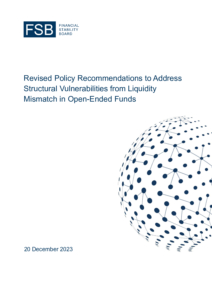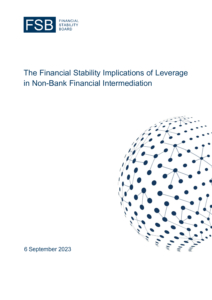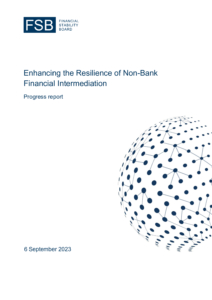The views expressed in these remarks are those of the speaker in his role as FSB Chair and do not necessarily reflect those of the FSB or its members.
Good afternoon. It is great to be back in Dublin in this impressive building of the Central Bank of Ireland.
The Dutch central bank will be moving into its renovated headquarters in December, so I can’t help paying attention to my architectural environment. But that’s not the only reason.
The way architects look at the foundation and resilience of their buildings resembles the way the Financial Stability Board (FSB) looks at the financial system. A structure, after all, is only as strong as its weakest point.
15 years ago, the global financial system was on the verge of collapse. There were, in fact, many weak points. But, we know that non-banks, including investment funds, played a role in that global financial crisis.1
More recently, there was the March 2020 turmoil,2 and indeed other incidents, such as the failure of Archegos and the LDI turmoil.
These events have been further reminders of one simple fact: there remain key vulnerabilities within NBFI. The basic regulatory structure is not strong enough.
In recent years, the FSB and the international standard-setting bodies have been working hard to address these NBFI vulnerabilities. We have made progress, but there is still more to do.
Just like this fantastic building, we are aiming to construct something that can stand the test of time. Something that functions well through hot spells and big storms.
For a resilient structure we need a solid regulatory foundation. Then, macroprudential measures could be added to the design to further support the structure, where needed. Measures that may change over time and could differ from one jurisdiction to the next. Measures that are complements to, but not substitutes for, the baseline set of regulations.
Therefore, to me, a successful macroprudential approach depends on the completion and proper implementation of the international regulations the FSB has been developing.
In the remainder of this speech, I will discuss in more detail the FSB’s recent work in the area of investment funds and NBFI more broadly. I will then offer some thoughts on the next steps at the international level towards a macroprudential approach.
The NBFI sector has grown substantially since 2008, to almost half of global financial assets. It has also become more diverse. As a result, NBFI is increasingly important for the financing of the real economy.
More diverse financing channels are beneficial to the real economy. But the flipside is that vulnerabilities within the NBFI sector can increasingly threaten financial stability.
To address these vulnerabilities, the FSB has been looking at imbalances between liquidity demand and supply. Let me highlight a few important factors.
First of all, liquidity mismatches reduce the ability of certain non-bank entities to handle shifts in liquidity demand. Consider an investment fund that offers its investors the possibility of daily redemptions, with no notice period. If the fund has invested for a large part in illiquid or less liquid assets, it may struggle to sell assets to meet redemptions, especially in challenging market conditions. In turn, redemptions may increase if investors are worried that the fund cannot facilitate them.
On the liquidity supply side, we are also seeing challenges. For example, bank dealers may be unable to absorb large selling pressures during times of stress, as their balance sheets have generally not kept pace with the increase in the size of debt markets.
Having analysed both liquidity supply and demand, the FSB is working on policies to prevent the mismatch from becoming excessive. Last year, the FSB revised its policy recommendations on addressing vulnerabilities from liquidity mismatch in open-ended funds. The FSB also published policy proposals to enhance the resilience of money market funds in 2021. The ultimate objective in both cases is to improve liquidity risk management by fund managers.
The FSB has also been working on margin and collateral calls. Unexpectedly large calls contribute to shifts in liquidity demand and can create stress if market participants are insufficiently prepared for them. Last month, the FSB launched a consultation for its policy work in this area. The recommendations aim to reduce excessive procyclical behaviour in response to margin and collateral calls. This work will be finalised by year end.
Further, the FSB is currently exploring policies to address financial stability risks from leverage in NBFI. We know that leverage has the potential to amplify losses through position liquidations or counterparty defaults. Leverage can also worsen liquidity stress, for example via margin calls on collateralised leveraged positions. We aim to enhance the monitoring of leverage in NBFI and address related vulnerabilities.
The FSB is also soon going to publish an examination of the structural issues in some key short-term funding markets that prevent liquidity supply from matching demand during periods of turmoil.
It is important to keep in mind that the NBFI ecosystem is highly connected across entities, and with the banking sector. This creates the risk that local stress will be transmitted to other parts of the financial system and across borders. For this reason, global financial stability is increasingly dependent upon a resilient NBFI ecosystem.
We expect to see this resilience increase as national and regional authorities implement the FSB policy recommendations. But, of course, that is not the end of this story. As we monitor implementation, we will also pay close attention to assessing the effectiveness of these new policies.
I should mention that our starting point for this work was to acknowledge that the existing policy toolkit for NBFI is extensive. But, these tools were primarily investor protection focussed. Hence, to date, FSB policy proposals have largely repurposed existing policy tools rather than creating new ones. Clearly that means that the real-world experience with using these tools for systemic risk mitigation is limited. So, it will be important to assess whether the repurposing of existing tools is sufficient to address systemic risks in NBFI – or whether new tools are needed.
What I have described so far takes care of the foundational part of the structure. But what about the additional features? What about a macroprudential approach?
Well, the FSB plans to begin this phase by discussing members’ experiences, and the lessons learnt in the design and use of their own macroprudential tools. These lessons may then inform best practices at the international level. That’s why I applaud the Central Bank of Ireland (CBI) for arranging this conference. The CBI’s own experiences, including with the recent actions it’s taken to enhance the resilience of its non-bank sector are of great interest to us. The same is true for macroprudential actions for non-banks taken by other authorities.
One might say that, in developing our policy measures, we should look at the tried and tested approach for banks. And indeed, as we have seen in banking, a macroprudential approach may be useful to lean against the build-up of cyclical vulnerabilities or to address concentration risk.
But we mustn’t lose sight of how complex and diverse the NBFI ecosystem is. And the difference in how systemic risk propagates. In the NBFI sector this is likely driven more by activities and collective actions, and less by the size of specific entities, as it is in banking.
And so, macroprudential policy for NBFI might differ in important ways from the approach used in banking.
A further consideration for macroprudential policy is the need to enhance our capabilities in the area of data and analytical tools. The data landscape for NBFI is not as well developed as for banks. To improve this, the FSB is exploring ways to enhance the availability, quality and usability of data. We are also working on the development of additional metrics and new analytical tools to monitor NBFI vulnerabilities on an ongoing basis. For example, stress testing of funds is an important topic for which the FSB will organise a workshop in July, jointly with IOSCO.
Lastly, we know that macroprudential policy has important cross border implications, including in terms of reciprocity and home-host considerations. These call for international cooperation. The FSB is well placed to support efforts to achieve this, working alongside key standard setters, like IOSCO.
Let me wrap up.
We have seen several market incidents recently. Incidents that were due to vulnerabilities in the NBFI sector. And though the incidents were overcome, in some cases relying on extraordinary central bank interventions, the underlying vulnerabilities and the amplifiers of stress are still largely in place. This means, for example, that investment funds remain vulnerable to further liquidity strains. And so, it is critical to finalise and implement international reforms to enhance NBFI resilience.
Thereafter, we will be well placed to assess whether any regulatory gaps remain and to move forward toward a macroprudential approach.
Today’s conference provides an important opportunity to discuss what that could look like.
This fantastic building we are gathered in, is set on a solid foundation. With a resilient – ‘Irishweatherproof’ – structure. And it is actually two buildings – unified around an atrium that draws in the light.
Very much in this building’s spirit, the FSB will continue to unify countries, sectors and market activities around strong regulation. It will continue to shed light on shared vulnerabilities. And it will continue to foster a resilient financial system for all seasons.
Thank you.
- See, for example, the findings of the U.S. Financial Crisis Inquiry Commission. ↩︎
- See the FSB’s Holistic Review into the March 2020 Turmoil. ↩︎



